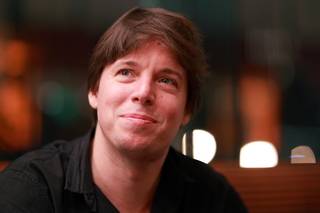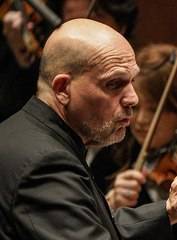|
Back
Stratospheric Music New York
Wu Tsai Theater, David Geffen Hall, Lincoln Center
09/29/2023 - & September 30, October 1*, 2023
The Elements (American Premiere): Kevin Puts: Earth; Edgar Meyer: Water; Jake Heggie: Fire; Jennifer Higdon: Air; Jessie Montgomery: Space
Aaron Copland: Symphony No.3
Joshua Bell (Violinist)
New York Philharmonic Orchestra, Jaap van Zweden (Conductor)

J. Bell (© Alex Duff)
“Why not other elements besides fire, air, earth and water? What a pity! Why aren’t there forty elements instead, or four hundred, or four thousand? How paltry everything is, how miserly, how wretched! Stingily given, aridly invented, heavily made!”
Guy de Maupassant
“Of the four elements water is the second in weight and the second in respect of mobility. It is never at rest until it unites with the sea.”
Leonardo da Vinci
When Joshua Bell tackles his usual choice of traditional classics, he inevitably blasts them from earth into a fiddler’s stratosphere. Recently he went contemporary, commissioning five American composers to venture into the stratosphere and planetary together. The result during the American premiere this weekend was both a celebration and as cerebration.
Like the obvious progenitor, Vivaldi’s Seasons, Mr. Bell brought a quintet of composers. They had to be inspired by a trio of earth elements (water, fire, earth itself) and two stratospheric elements (air and space). The result was a gorgeous entertainment. Not as transcendent as its subjects. But with Joshua Bell always at his most mesmeric, we had five pieces which surveyed the limits of his instrumental, along with usually dazzling color by Jaap van Zweden’s New York Philharmonic.
Did the music live up its titles? That varied, “Earth” was close enough to a spaceship view of our planet. Kevin Puts began with the a near silence, a content of faraway visions so utterly euphoric, that one almost regretted a second more chaotic section. Still, while one was charmed by Mr. Bell’s opening, anything bringing his seamless technique to the fore was welcome.
Edgar Meyer is such an eclectic master, from country to classical, that one could understand his near‑literal “Water” rippling, a charming update from Moldau to a virtuoso’s showpiece.
Jake Heggie’s “Fire” was exactly what one expected. A few tense chords and a sudden sforzando of blaze. Still, this was hardly Scriabin’s fire. We had particles and flames and–above all–the incendiary fire of Mr. Bell, running up and down his instrument. The audience was suitably respectful between movements, yet here the violin brought forth a momentary eruption.
The last two sections inevitably blended into one another. Jennifer Higdon’s “Air” exhibited (in her words) “high energy. swirling notes. and a calm spot.”
The penultimate work, before Kevin Puts’ beautiful reprise at the end was Jessie Montgomery’s “Space”. That was of course impossible. Ms. Montgomery’s explanation was “to pull the listener into their own imagination of the universe.” And it was a deftly constructed work. One could use imagination, true, but the title summoned up solar gasses, comets and space junk.
The reality for this listener was the cosmologist’s concept of total silence. I felt The Elements was successful as a tour de force for a master violinist like Joshua Bell. But “Space”? The reality was John Cage’s 4’33”.
As Walt Whitman “Look’d up in perfect silence at the stars.”
So one approaches this like approaching Holst’s Planets. Five mini-concerto movements, each with its own intriguing personality, a joy for any virtuoso and any conductor. The Elements was not literal. It was an imaginary simulation, And one hardly had to envision its subjects to delight in the sounds of soloist and orchestra.

J. van Zweden (© New York Philharmonic)
Conductor van Zweden was faultless in his choice of second work. Aaron Copland was always colorful, but he didn’t need a subtitle for his Third Symphony. Anything like “Fire” or “Space” would be superfluous. Instead this was a fabulous Concerto for Brasses, Timpani and Percussion.
Yes, the Andantino started with pastoral lightness. But the other three movements were volatile, jubilant, and clamorous bijoux for the instruments above. When Jaap van Zweden joined the Philharmonic in 2018, some had doubts of his devotion to modern music. Not only has he proven them wrong, but his championship of Julia Wolfe, John Luther Adams et al, and his muscular mastery of the Copland were proof of his artistic allegiance to America.
Harry Rolnick
|